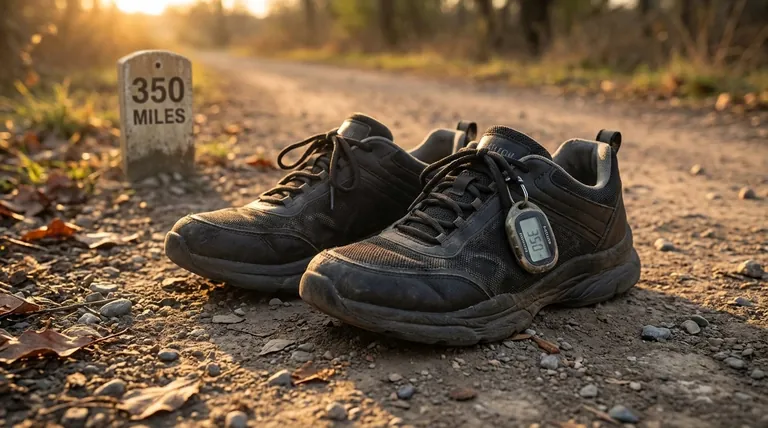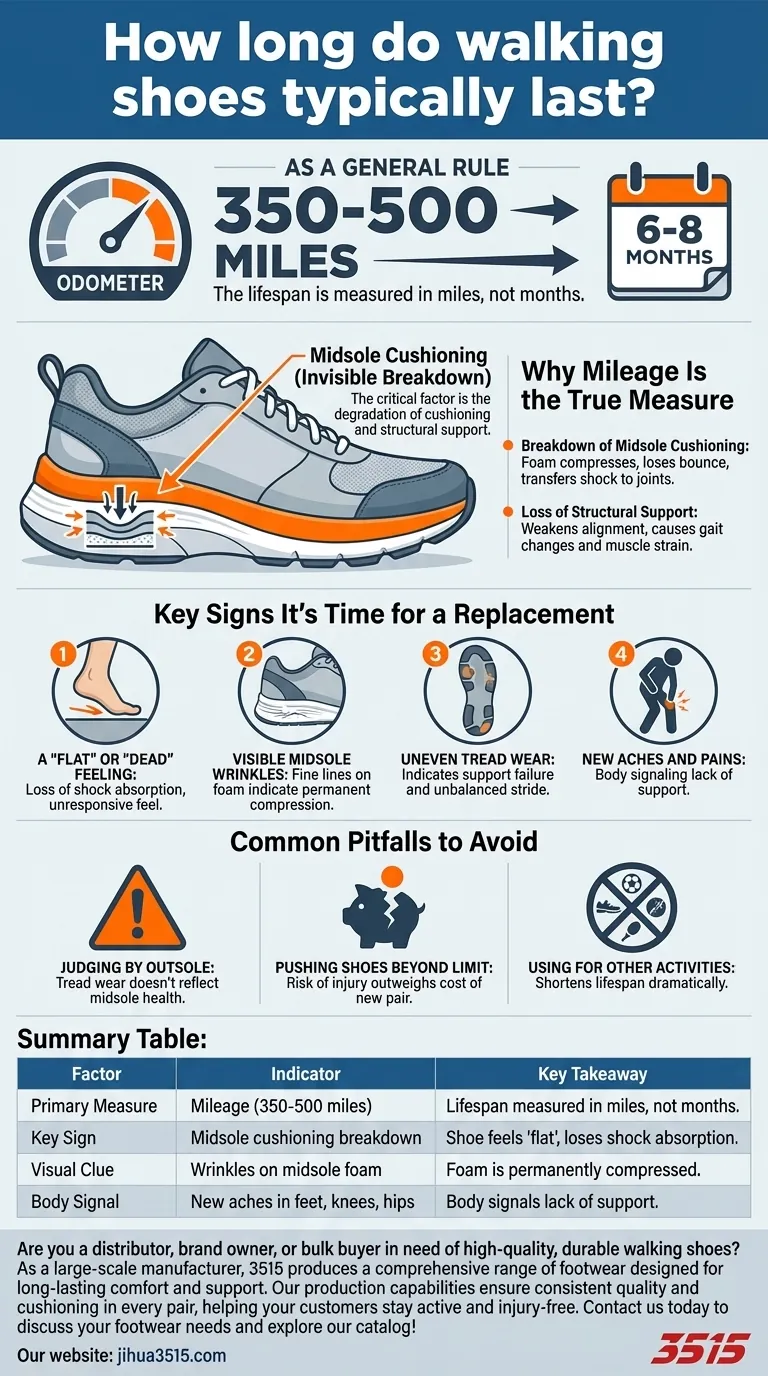As a general rule, a quality pair of walking shoes will last between 350 and 500 miles of use. For someone who walks regularly, this typically translates to replacing them every six to eight months. The critical factor is not time, but the degradation of the shoe's cushioning and structural support, which breaks down with each step.
The lifespan of a walking shoe is measured in miles, not months. Relying on visual wear is a common mistake; the real indicator for replacement is the invisible breakdown of midsole cushioning, which is essential for protecting your joints from injury.

Why Mileage Is the True Measure
Many people wait until their shoes look worn out, but the most important components fail long before the tread is gone. The real issue is the gradual, invisible collapse of the shoe's internal structure.
The Breakdown of Midsole Cushioning
The soft, shock-absorbing layer between your foot and the rubber outsole is called the midsole. It's typically made of a foam material that compresses with every step to absorb impact.
Over hundreds of miles, this foam loses its ability to bounce back, becoming permanently compressed. When this happens, more shock is transferred to your feet, ankles, and knees.
The Loss of Structural Support
Beyond cushioning, a good walking shoe provides stability to keep your foot properly aligned. As the materials fatigue, this structural integrity weakens.
This can lead to subtle changes in your gait, which may cause strain on muscles and ligaments that aren't accustomed to the extra work.
Key Signs It's Time for a Replacement
Since the 350-500 mile range is a guideline, you must learn to recognize the physical signs of a worn-out shoe. These are far more reliable than just tracking the calendar.
A "Flat" or "Dead" Feeling
A new shoe has a responsive, cushioned feel. A shoe that is past its prime will feel hard, flat, and unresponsive underfoot. The shock absorption is simply gone.
Visible Midsole Wrinkles
Examine the foam midsole on the sides of your shoe. Fine, horizontal wrinkles are a clear sign that the foam has been repeatedly compressed and is breaking down.
Uneven Tread Wear
Look at the bottom of your shoes. While some wear is normal, excessively worn-down areas, especially if they are uneven, indicate the support structure is failing to maintain a balanced stride.
New Aches and Pains
If you start experiencing new pain in your feet, shins, knees, or hips after your walks, your shoes should be the first thing you investigate. This is your body telling you it's no longer getting the support it needs.
Common Pitfalls to Avoid
Making an objective assessment of your footwear can be difficult. Be aware of these common mistakes that can lead to discomfort or injury.
Judging a Shoe by Its Outsole
The durable rubber outsole is often the last part of the shoe to show significant wear. You cannot judge the health of the critical midsole by looking at the tread on the bottom.
Pushing Shoes Beyond Their Limit
Trying to get a few extra months out of a pair of shoes is a false economy. The potential cost of dealing with an injury caused by inadequate support far outweighs the price of a new pair.
Using Walking Shoes for Other Activities
Using your walking shoes for running or court sports will dramatically shorten their lifespan. These activities generate different forces that break down the shoe's specific support systems much faster.
Making the Right Choice for Your Goal
Your replacement schedule should be based on your unique activity level and what your body is telling you.
- If your primary focus is casual, daily walking: Pay attention to the six-month mark and how the shoes feel. If they no longer feel cushioned and supportive, it's time to replace them.
- If your primary focus is fitness walking and logging miles: Track your mileage using a simple notebook or a fitness app. Start checking for signs of wear around the 350-mile mark.
- If your primary focus is avoiding pain or injury: Be proactive. Do not wait for pain to be your reminder. Replace your shoes based on mileage, and never hesitate to replace them sooner if you feel any new discomfort.
Ultimately, investing in proper footwear is a direct investment in your health and ability to stay active.
Summary Table:
| Factor | Indicator | Key Takeaway |
|---|---|---|
| Primary Measure | Mileage (350-500 miles) | Lifespan is measured in miles, not months. |
| Key Sign | Midsole cushioning breakdown | The shoe feels 'flat' and loses shock absorption. |
| Visual Clue | Wrinkles on the midsole foam | Indicates the foam is permanently compressed. |
| Body Signal | New aches in feet, knees, or hips | Your body signals a lack of support. |
Are you a distributor, brand owner, or bulk buyer in need of high-quality, durable walking shoes?
As a large-scale manufacturer, 3515 produces a comprehensive range of footwear designed for long-lasting comfort and support. Our production capabilities ensure consistent quality and cushioning in every pair, helping your customers stay active and injury-free.
Contact us today to discuss your footwear needs and explore our catalog!
Visual Guide

Related Products
- Wholesale Breathable Training Shoes Custom Athletic Footwear Manufacturer
- Wholesale Durable & Breathable Training Shoes for Custom Brands
- Durable Rubber-Soled Utility Shoes for Wholesale & Custom Brand Manufacturing
- Lightweight Breathable Sneakers with Wet-Traction Grip for Wholesale & Private Label
- Wholesale Lightweight Cushioned Athletic Sneakers for Custom Bulk Production
People Also Ask
- What are the benefits of breathable materials in work shoes? Enhance Comfort & Health for Your Workforce
- Does more ground contact area mean better support? Unlock the Secrets of Stable Footwear
- What are the benefits of breathable mesh in shoe design? Enhance Comfort and Performance
- What are the characteristics of canvas as a shoe material? A Guide to Lightweight, Breathable Footwear
- What should be considered when choosing smart trainers for business casual? A Guide to Professional Style



















